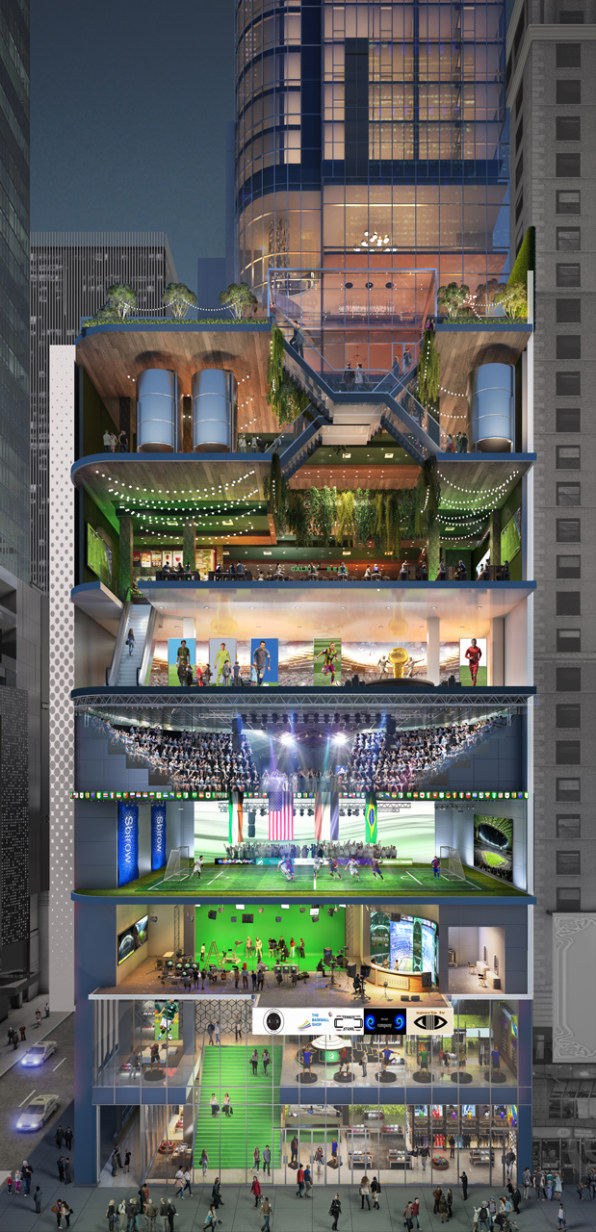It’s 10 a.m. and I’m sitting at a long white counter in a midtown Manhattan office having bacon and eggs with David Levinson, owner of some of New York’s most prized real estate, and Andrew Essex, former CEO of the innovative ad agency Droga5. Essex is consulting with Levinson’s real estate firm on a $2.5 billion project that will bring down the old DoubleTree hotel in Times Square and, in its place, erect a 46-story building with a soaring LED flecked tower, three full-bleed screens, and a sweeping open stage that hovers 30 feet above the red staircase of the TKTS ticket booth. Levinson is now on the hunt for a tenant to occupy the building’s epic retail space.
The TSX Broadway building, as it’s been dubbed, is a three-year project being developed through a partnership with L&L Holding Company, Maefield Development, and Fortress Investment Group that will begin construction in early 2019. It is a maximalist vision of futuristic retail. The space can support concerts overlooking a massive audience in Times Square and broadcast the performance via a giant screen that encompasses the stage and wraps around the edge of the building. Inside, it has a 75,000-square-foot flexible space equipped with cameras, sensors, and Wi-Fi, all of which can be used to collect tons of consumer data on the millions of people that are expected to walk through the building each year.
This is the future of brand advertising: death to traditional retail spaces and ad media as we know them, replaced by gargantuan spaces intended to sell consumers products through “experiences.”
But before we talk about the building, Levinson is telling me about the latest drop from Supreme, in which the fashion label released its newest batch of merchandise online and super fans tried to get a piece before it all sold out. He says that, yesterday morning, his teenage son couldn’t stop talking about it. “My son was like, ‘Ahh, I’m never gonna get this stuff,’” says Levinson, a pair of stemless reading glasses perched on the edge of his nose.
“You have to have fast thumbs,” Essex says, wiggling his thumbs against a imaginary phone.
The Supreme “drop” is an apt example of the new state of retail-as-experience: a timed sales event meant to generate sales through anticipation and pent-up demand. Fans wait eagerly online for the merchandise, much like music junkies anticipate a new album. The clothes sell out almost immediately, scooped up by bots and resold on various online platforms for much more than their original value—hence Levinson’s son’s consternation.
STORES AS SHOWROOMS
The experience of buying Supreme is very representative of the ways in which the retail experience is being rejiggered these days. Where it was once popular to have a wide variety of merchandise in stores, curated boutique experiences are now all the rage. Brands are increasingly adopting a “showroom” style of store, the kind Apple pioneered, that is more about the physical experience of shopping than walking out with bags.
If you’ve ever been to New York’s SoHo shopping district on a Saturday, you’ve no doubt encountered the reliable line that forms outside of the Everlane on Prince Street. The company limits the number of people who can be in the store at one time, which simultaneously makes perusing the racks more pleasant and gives Everlane’s clothes the appearance of being highly sought after. Supreme, too, is known for the lines that form outside its stores in New York, London, Paris—this is shopping in 2018. The retail experience doubles as the advertisement.

No one is more aware of the way that retail is changing than Levinson. Over the years, he has been thoughtful about putting experience-minded tenants into his buildings. Back in 2010, he secured Eataly as a tenant in the Fifth Avenue Toy Factory and helped bring to life a giant market peppered with mini restaurants throughout. Fittingly, Lego retains an interactive store where visitors can build up their own fortresses. You may also be familiar with Levinson’s Tribeca property, where Nobu shines opulently.
The new TSX Broadway building on Broadway at 47th Street will be constructed around the Palace Theatre and includes space for a 669-room hotel. The building is designed for much more than selling T-shirts. It is designed with the modern shopping experience in mind. When Levinson talks about future tenants for the site, he talks about a company capable of hosting product launches, album releases, e-sport tournaments, and interactive showrooms.
The building is not only a response to a shifting retail landscape, it’s also a reflection of changes in the advertising world. “The 30-second spot is going away because of over-the-top television,” says Essex. “Print insertion is going away, and banner ads are being blocked by—in some instances—one in four Americans. There is a rush toward external signage and big plays like Citi Bike, because people are sensitive to messages in public places. You can’t avoid them.”
Brands, perhaps a bit cynical about the value of online advertising, are expected to spend about one-fifth of their budgets on experiences like Casper’s nap lounge or Refinery 29’s 29Rooms. But to make these events work, they need to have high traffic.
“You look for a place where there are tons of impressions, where there’s incredible human traffic, and Times Square is that place,” says Essex.
Between 300,000 to 400,000 people pass through Times Square on a given day, depending on the time of year. Having a presence in the district, with the ability to host events that can be seen from the street and screens that can echo onstage performances for maximum viewership, is not only an opportunity to get more impressions, it’s also an opportunity to collect an immense amount of data.
Brick-and-mortar stores have had the ability to capture data on their customers as they shop for years now. This sort of technology is how a company like Samsung can justify building out a 55,000-square-foot retail space that doesn’t sell any actual merchandise. In Samsung’s case, it’s a playground for gadget nerds, a chance for someone to sling a VR headset around their face and immerse themselves into a virtual experience. While visitors get to test out new tech, the company gets to collect a lot of information about the way people interact with its products. The space, which hosts concerts and conferences, also encourages selfies and social media posts—another way for Samsung to track its visitors.
Levinson’s TSX Broadway building is very much an iteration on this type of space, but much bigger in scale, and with the potential to attract a much bigger audience. “I think what happens in that building,” he says, “is going to be shared around the world in iPhones and iPads and streams.”

Recent Comments